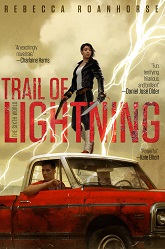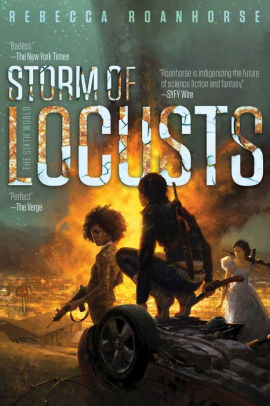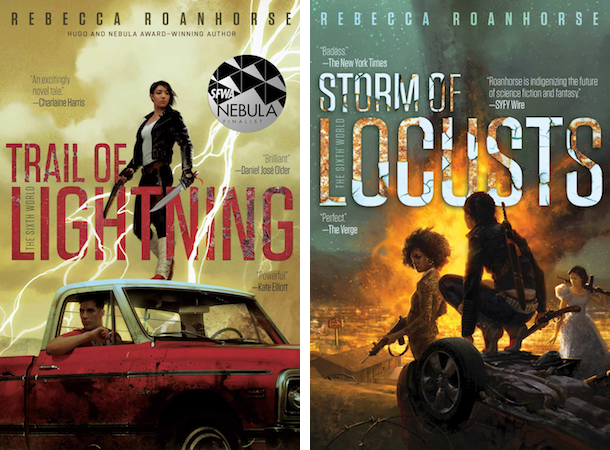When the cover for Rebecca Roanhorse’s Nebula Award-nominated debut novel Trail of Lightning was first revealed, the award-winning author emphasized how she hadn’t wanted Dinétah monster hunter Maggie Hoskie to be depicted in “the typical trappings non-Natives associate with Native Americans” such as feathers or braids. Yet she still wanted Maggie to be recognizably Navajo, which is why she wears traditional Navajo women’s moccasins alongside her leather jacket and knife. A similar discussion came out of Roanhorse’s 2018 Reddit AMA (Ask Me Anything) on r/fantasy, in which the author of the award-winning short story “Welcome to Your Authentic Indian Experience™” explained which aspects of Diné culture she incorporated as Easter eggs, and which were off-limits. It makes for fascinating insights into an already engaging novel that kicks off the post-apocalyptic urban fantasy series.
Storm of Locusts, the second installment in the Sixth World series, was published in early 2019. Roanhorse recently held another AMA on r/fantasy as part of The Pixel Project’s Read for Pixels campaign, raising awareness about the grim statistics around missing and murdered Indigenous women. The discussion covered the presence of the Hopi in future Sixth World novels, how #ownvoices SFF can address real-life violence in fiction, and some of Roanhorse’s favorite new reads.
Read on for highlights from both AMAs!
Redditor TerribleReturn asked:
I still haven’t read Trail of Lightning yet, but reading the interviews you’ve done in the lead up to its release has made me curious about your process for deciding which parts of Diné culture to include, which to make up, and which that were completely off-limits for the page. I’m sure that having Diné friends, family, and elders within reach throughout your writing of the book helped a lot, but was there ever a point where you felt in over your head, and if so, how did you ultimately deal with that? And do you think there were any aspects of your own Black/Pueblo heritage that bled into the worldbuilding or characters as well?
Buy the Book


Trail of Lightning
Roanhorse responded:
My goal with the book re: Diné culture, was accuracy and respect. The Navajo Nation is like my second home. I lived there fulltime for a few years, but over the last decade have traveled back regularly for weekends, family celebrations, etc. I love the place and the people and I wanted to share some of that love and hopefully give Navajo readers a chance to see themselves accurately portrayed and centered in Fantasy. There are so many Easter eggs in the book if you’re from the Window Rock/Gallup area, and I put those in for Navajo readers to enjoy and laugh at. Something off limits was ceremony. I didn’t include anything that one might experience in ceremony directly. And yes, I’m a fiction writer, a fantasy writer at that, so I made a lot of stuff up! Clan powers, for example. Completely a fiction. I also chose to focus on traditional stories (mythology) that is out there already in comic books and other SFF, mostly but not all by Navajo creators like Dale Ray DeForest—a favorite comic book artist of mine. I didn’t want to be the only one working with Navajo stories. And I’m sure my own heritage impacts everything I write. Remember, the only non-Navajo characters in the book are a Black family, the Goodacres, who will continue to play a big role in future books. And in Book 3, we come to The Burque, where you will undoubtedly see some Pueblo influence.
Later in the thread, Redditor booklover912 delved into specific moments tying the rural fantasy of Trail of Lightning to present day:
Even-though your novel is a urban/rural fantasy you’ve included heavy themes that are very prominent and real to Native American Women and Native Americans in general. Was their ever a moment during the writing process that you considered backing away from such topics (police brutality, abuse, kidnap/ missing person, ect) and if so what gave you the courage to take such a strong stance?
You said in an interview that you didn’t see the society in which you built as a dystonia/ dark world but instead a renaissance: How did you find the balance between creating a Navajo society full of strength while also creating an apocalyptic world?
Roanhorse matched their thoughtful questions with equally insightful answers:
I am so pleased that you noticed the contemporary issues I wove into the story, the biggest one for me being mental health, abuse and trauma, issues very prominent and important in the Native community, particularly for Native women. I think sometimes SFF allows the writer to talk about these things in a way that maybe wouldn’t work, or at least works differently, in literary fiction or non-fiction. It may seem frivolous for my characters to derive their superpowers from trauma, but, as Reddit user theheroellipsis astutely comments upthread, I’m saying something about being a survivor that doesn’t (hopefully) just become backstory or the typical “hero with a troubled past”. I want my characters to wrestle with their pasts, and not always win. I’m more afraid of writing milquetoast than I am of writing heavy themes. But also, I want to balance the heavy with fun. I think you can read TRAIL as just a fun adventure story, or you can see the deeper layers. It’s up to the reader.
re: balance. I just looked around me. That is the Native experience. I’m going to obnoxiously quote myself (forgive me—it’s 12:41 am here and I need to go to bed) but I wrote about this in an essay for Uncanny Magazine:
“To be a Native of North America is to exist in a space where the past and the future mix in a delicate swirl of the here-and-now. We stand with one foot always in the darkness that ended our world, and the other in a hope for our future as Indigenous people. It is from this apocalyptic in-between that the Indigenous voices in speculative fiction speak.”
In the 2019 AMA, FarragutCircle asked:
I absolutely loved Trail of Lightning, but one question I had about it was—what’s going on with the Hopi in this world? Their reservation is also within the Four Sacred Mountains lines (map) (My apologies if I missed any mention of them!)
Buy the Book


Storm of Locusts
Roanhorse’s response:
As for the Hopi, a Hopi character makes a brief appearance in the second book, Storm of Locusts, to let you know they’re doing okay, too. In fact, you get a glimpse of what’s become of the larger Southwest (esp Northern AZ) in the second book. And in the third book, we’ll be heading the other direction to the Burque to see what the Pueblos and the land-grant old school Hispanic families are up to.
The Pixel Project chimed in with some keen questions:
- Maggie Hoskie is a fantastic example of a well-rounded female character with agency who, in the course of her work and life, has deal with instances of sexism, misogyny, and violence against women and girls. What and who are your inspiration for Maggie?
- How do you think #ownvoices SFF can address types of violence against women that women and girls in the author’s community or culture experience?
- And finally: Now that the extremely urgent issue of murdered and missing Indigenous women is finally getting some – though still not nearly enough – attention, what do you think authors and other pop culture influencers can contribute to collective efforts do to further raise awareness and trigger action to address this by the wider community and the countries/nations where this is happening?
Thanking the organization for the opportunity to participate in the cause, Roanhorse responded:
- There’s a lot of me in Maggie but turned up to 11 and obviously fictionalized. All of her experiences and trauma and hurt are familiar to me and draw from my experiences as I have been a victim of violence myself. But I don’t think my experiences are that unique. I’m sure many women have been in similar situations and faced similar “monsters”. We are all fighting monsters. If not literal ones than certainly the metaphorical ones in our lives.
- I think the first function of fiction is to tell a good story. I want to be careful not to lose sight of that. But a good story can do so much more than entertain us. It gives us a chance to step into another person’s shoes and understand points of view we might not have considered before. It can allow us to gain empathy. I think authors, if we’re lucky enough, have a chance to offer a way into other lived experiences for our readers so they can suddenly find themselves identifying with a young Native woman on the reservation and her experiences in a way they could not have without story. Perhaps how we begin to address violence is by telling our stories.
- Talk about it. Post about it. Spread the word, esp when it’s someone near your community that has gone missing. Advocate for legislation that gives tribes funding and jurisdiction, and holds state law enforcement accountable when appropriate. Check out the links from Read for Pixels that I have in my introduction above. Become familiar with the various organizations trying to raise awareness and boost them. And if you’d never even heard of the Missing and Murdered Indigenous Women movement before this, take some time to educate yourself.
She also teased a bit about Between Earth and Sky (to be published in 2020), which she describes as “an Anasazi/Ancestral Puebloan/Indigenous-inspired epic fantasy where the great matriarchal clans of a prosperous cliff-city vie for power against a backdrop of political intrigue, celestial prophecies, rising rebellion & dark magic”:
Thanks! The book is still in revisions, so I don’t want to say too much and then ultimately be wrong, but it’s a secondary world fantasy inspired by the Indigenous Southwest of, say, 1100 CE/AD but with a futuristic spin, as well. Sort of a re-imagining of that world with its cities and trade routes and focus on astronomy – lots of history that gets left out when talking about Indigenous Americas history. Then add a bit of a sword and planet vibe, shake it all up, and see what happens. (I’m a serial mixer of genres. Apologies in advance.) Right now I’m thinking it’s a series because I want time to explore that huge world I have in my mind but, again, that’s ultimately up to my editor.
Love Roanhorse’s work and want to know what she loves? She helpfully lists three 2019 releases (hi, Gideon!) to add to your TBR:
The Light Brigade by Kameron Hurley – Starship Troopers meets Edge of Tomorrow. A dark vision of the endless corporate wars of the future and the soldiers who fight in them. Ends with hope, though. Amazing craft and construction to set up the timeline and the mystery. Fast-paced and gripping.
Gideon the Ninth by Tamsyn Muir – Pure space goth joy. Funny, acerbic wit, great characters and a mystery to solve. It’s gonna be big.
Gods of Jade and Shadow by Silvia Moreno-Garcia. Set in 1920’s Mexico, a story of the Maya God of Death and a woman who go on a journey to reclaim what his brother has stolen from him. Poignant, beautifully-realized, and just lovely.
(Gideon the Ninth will be published September 10; read the first six chapters here!)
Other highlights from Roanhorse’s 2018 AMA include her unofficial Trail of Lightning soundtrack, Star Wars love, and her recommendation for the best greasy green chile cheeseburger in New Mexico. You can read the rest of her 2019 AMA for more insights, and for Roanhorse geeking out about LeVar Burton reading “Welcome to Your Authentic Indian Experience™” on his podcast LeVar Burton Reads.
This piece was originally published in July 2018 and has been updated since.










